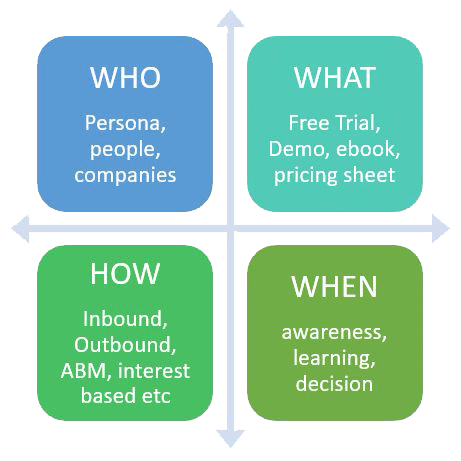The difference between strategy and execution in marketing is decision-making. Strategy is the combination of play calls that your SaaS marketing agency makes on your behalf. Execution is the set of tactics that the analysts will execute. We can show you stats on execution all day long, but at the end of the day, all you really want to know is: “Did we win?”. Start building your strategy by addressing the who, what, how and when using a SaaS marketing decision-making matrix.
Let’s use a football analogy to elaborate. Since we’re based in Dallas, I’m going to use the Cowboys-Packers rivalry in this case. Since 2015, the Green Bay Packers have owned the Cowboys. They have won 5 of the last 6 games played between the two teams. Statistically speaking, the Cowboys match up toe to toe with the Packers. But time and again, the Dallas Cowboys have come up short. What’s the difference between these two teams then? Strategy and tactics.
A Great SaaS Marketing Decision-Making Matrix to Build Strategy
So let’s dive a little deeper into what it means to formulate a SaaS marketing strategy.
Here is the SaaS marketing decision-making matrix we use when we put together a marketing strategy:

As the CEO/CRO/founder of your company, you have set certain top line goals for the company. These goals are typically to grow revenue/customers for the year/half year etc. Depending on the stage of your SaaS company, you may also have an idea about your most valuable market segment.
Your SaaS marketing agency will take your top line goals and convert them into a set of marketing play calls. The idea is to test these play calls to figure out which ones will get you game winning touchdowns, and then to repeat these calls over and over until your goals are achieved.
Here are some examples:
Let’s say you have a goal to grow subscribers to 1,000 in the next 12 months for your SaaS, and you believe that Healthcare and Hospitality are the two vertical targets that will get you there.
Determining the “Who”:

Knowing that your target segments are Hospitality and Healthcare, your agency will set about understanding the target persona for each segment. In addition, size of the company and other metrics that are important are also analyzed. At the end of the exercise, the analysts end up with a set of options – specific personas such as the CTO, the buyer, or the COO at companies with 10-100 or < 1000 employees, based in the US. Depending on how many combinations you want to explore, select the top few ‘whos’:
- COO at hospitality companies based in the US with up to 1,000 employees
- Buyer at Healthcare companies based in the US with up to 1,000 employees
Once you know the specificity of the audience, you can then make decisions on the other aspects of the marketing matrix.
Determining the “How”:

The next critical part of the SaaS marketing decision-making matrix is to determine how to reach the audience. If you have a marketing list, then email might be an option. However, chances are that this list is either outdated or is incomplete. So there is an exercise in identifying the audience that needs to happen. This is part of the “how”. Once that is complete, determine the right combination of channels that should be used to target your audience. More often than not, there is a combination of multiple channels and additional follow ups that will get your audience’s attention. For example:
- LinkedIn + Facebook + Email + re-targeting over a 4-week period
- Google ads + re-targeting + snail mail over an 8-week period
Why multiple channels? Because it takes many touches to get your audience’s attention. The trick is finding the right number so your message stays appealing to your audience.
Determining the “What” & the “When”:

These two decisions actually go hand in hand. The “when” doesn’t refer to a particular point in time as much as it refers to the point in the buyer’s journey we want to target. For example, if you are a SaaS that is establishing product-market fit, then your agency’s job is to drive awareness of the problem. Consequently, they will target the ‘top of the funnel’ in the buyer’s journey for marketing. On the other hand, if you are a transitionary SaaS, then your agency will likely focus on acquiring bottom of the funnel because you have already established the market need.
Once the “when” is determined, then the “what” is identified. This could be ebooks, case studies, or call to action to try out your SaaS, depending on the stage of the buyer’s journey we want to target.
Pull all these components together into a small set of play calls that have promise. For example:
Target COOs at US-based hospitality companies with up to 1,000 employees using a combination of LinkedIn, Facebook, and email. Target them at the top of the funnel and make them aware of a problem that your SaaS solves by offering them an ebook.
OR
Target COOs at (insert the rest of the audience attributes) using a combination of (insert set of channels). Target them at the bottom of the funnel and offer them compelling case studies along with an offer for a free-trial.
Once these exercises have been completed, you now have a SaaS marketing strategy that can be tested out.
Building these attributes takes time, and there is significant risk associated with each decision. This is where a SaaS marketing agency can come in and provide guidance in both strategy and execution to increase your chances of winning the game.
So the next time your agency says they are going to spend time thinking through the marketing strategy, ask them what they mean and make sure they are going to put together a game plan for you!



